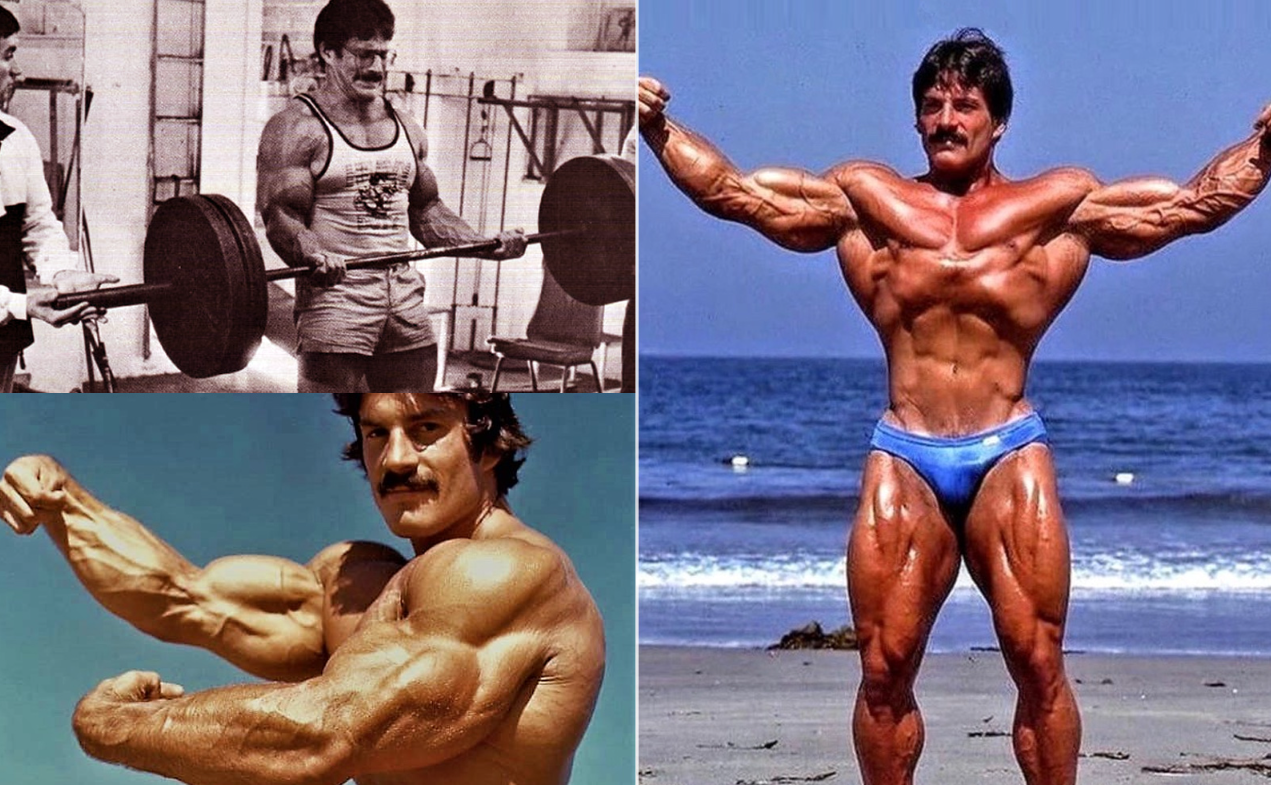Ever wondered how the bodybuilding legends of the past built their impressive physiques? One name that stands out is Mike Mentzer.
He wasn’t just another muscleman; he was a game-changer in the world of bodybuilding. Mentzer brought something new to the table – a training method called “Heavy Duty” that shook up the bodybuilding world.
In this article, we’re going to dive deep into Mike Mentzer’s workout and diet plan. We’ll look at his unique training philosophy, break down his workout routines, and explore the eating habits that fueled his incredible physique.
Whether you’re a seasoned gym-goer or just starting, there’s a lot to learn from Mentzer’s approach.
Mentzer wasn’t about endless hours in the gym or lifting weights until you drop. Instead, he believed in working smarter, not harder. His methods were all about high intensity and efficiency.
He proved that you don’t need to spend all day in the gym to build an impressive physique.
We’ll also touch on how Mentzer’s ideas influenced other bodybuilders, including some big names you might know. Plus, we’ll give you some practical tips on how you can apply Mentzer’s principles to your workouts.
Mike Mentzer Workout Routine and Diet Plan

So, if you’re ready to learn about a different way of building muscle – one that might just change how you think about working out – keep reading.
Let’s explore the world of Mike Mentzer’s Heavy Duty training and find out what made it so special.
The Heavy Duty Mike Mentzer Workout Routine

Mike Mentzer wasn’t just another face in the crowd of 1970s bodybuilders. He stood out because of his unique approach to training.
This approach, which he called “Heavy Duty,” was different from what most bodybuilders were doing at the time.
What Made Heavy Duty Different?
- High Intensity: Mentzer believed in pushing each set to the absolute limit.
- Low Volume: Unlike many bodybuilders who did lots of sets, Mentzer kept his workouts short.
- Heavy Weights: As the name suggests, Heavy Duty means lifting heavy.
- Less Frequent Training: Mentzer trained less often than most, giving his body more time to recover.
Mentzer didn’t come up with these ideas out of thin air. He built on the high-intensity training principles of Arthur Jones, the man who invented Nautilus exercise equipment. But Mentzer took these ideas further, creating his system.
The Birth of Heavy Duty
Mentzer’s Heavy Duty system was born out of his experiments with training. He found that when he trained with more intensity but less often, his muscles grew better.
This was a big shift from the common belief that more training always meant better results.
Here’s what sets Heavy Duty apart:
- Lower Reps: While Jones suggested 20 reps, Mentzer found 6-8 reps worked best.
- Absolute Failure: Each set was taken to the point where another rep was impossible.
- Beyond Failure: Mentzer used techniques to push past normal failure.
- Less is More: He did fewer sets per body part than most bodybuilders.
Mentzer’s approach was based on the idea that if you truly train with high intensity, you don’t need high volume. He argued that too much volume could hurt your progress.
The Impact of Heavy Duty
Heavy Duty training helped Mentzer build an impressive physique. He even won the heavyweight class at the 1979 Mr. Olympia. His success made people take notice of his training methods.
But Heavy Duty wasn’t just about building muscle. Mentzer saw it as a more logical, scientific approach to bodybuilding. He believed that by understanding how muscles grow, you could train more efficiently.
Mike Mentzer’s Workout Philosophy
Mike Mentzer’s workout philosophy was built on a few key principles. These ideas shaped how he trained and how he taught others to train.
1. Intensity Over Volume
Mentzer believed that intensity was the key to muscle growth, not volume. He defined intensity as how hard you push yourself in each set. For Mentzer, one set taken to absolute failure was better than several sets that stopped short of failure.
2. Training to Failure and Beyond
In Mentzer’s view, just reaching failure wasn’t enough. He used several techniques to push past normal failure:
- Forced Reps: A training partner helps you do a few more reps after you can’t do any more on your own.
- Negative Reps: You focus on lowering the weight slowly after you can’t lift it anymore.
- Rest-Pause: You rest for a short time after reaching failure, then try to do more reps.
- Pre-Exhaust Supersets: You do an isolation exercise right before a compound exercise for the same muscle group.
3. Low Volume and Frequency
Unlike many bodybuilders who did many sets per body part, Mentzer kept his volume low. He typically did only 3-6 working sets per body part. He also trained each muscle group less often, usually twice every 8-9 days.
4. The Importance of Recovery
Mentzer believed that muscles grow during rest, not during workouts. That’s why he emphasized giving muscles enough time to recover between workouts. He only trained three days a week, which was less than most bodybuilders at the time.
5. Progressive Overload
While Mentzer kept his volume low, he emphasized getting stronger over time. He believed that if you could lift more weight for the same number of reps, your muscles would have to grow.
6. Mind-Muscle Connection
Mentzer stressed the importance of focusing on the muscle you’re working. He believed that this mental connection could help you get more out of each rep.
7. Quality Over Quantity
In all aspects of his training, Mentzer favored quality over quantity. He believed that if you truly train with high intensity, you don’t need to do a lot of volume or train very often.
8. Individualization
Mentzer recognized that not everyone would respond the same way to Heavy Duty training. He often adjusted his recommendations based on an individual’s recovery ability and response to training.
Mike Mentzer’s Workout Routine
Now that we understand Mentzer’s philosophy, let’s look at how he put it into practice. Mentzer’s workout was split into two main routines: Workout A and Workout B.
Workout A (Legs, Chest, and Triceps)
This workout focused on the lower body and pushing muscles of the upper body.
| Exercise | Sets | Reps |
|---|---|---|
| Leg Extension (superset with Leg Press) | 2 sets of each | 6-8 |
| Squat | 1 | 6-8 |
| Leg Curl | 2 | 6-8 |
| Standing Calf Raise | 2 | 6-8 |
| Calf Press | 1 | 6-8 |
| Dumbbell Fly or Pec Deck | 2 | 6-8 |
| Incline Barbell Press | 2 | 6-8 |
| Dips | 2 | 6-8 |
| Pushdown (superset with Dips again) | 1 set of each | 6-8 |
| Lying Triceps Extension | 2 | 6-8 |
Key Points about Workout A:
- The leg routine starts with a pre-exhaust superset of leg extensions and leg presses.
- Only one set of squats is performed, but it’s done with maximum intensity.
- Chest training includes both isolation (flyes) and compound (presses) movements.
- Triceps are hit with both bodyweight (dips) and machine/free weight exercises.
Workout B (Back, Traps, Shoulders, Biceps)
This workout targets the pulling muscles of the upper body, along with the shoulders and biceps.
| Exercise | Sets | Reps |
|---|---|---|
| Machine Pullover (superset with Close Grip Underhand Pulldown) | 2 sets of each | 6-8 |
| Barbell Row | 2 | 6-8 |
| Machine Shrug (superset with Upright Row) | 2 sets of each | 6-8 |
| Side Lateral Raises (superset with Machine Shoulder Press) | 2 sets of each | 6-8 |
| Dumbbell or Machine Rear Lateral | 2 | 6-8 |
| Standing Barbell Curl | 1 | 6-8 |
| Dumbbell Concentration Curl | 2 | 6-8 |
Key Points about Workout B:
- Back training starts with a pre-exhaust superset of pullovers and pulldowns.
- Traps are hit with both machine work and free weights.
- Shoulder training includes exercises for all three deltoid heads.
- Biceps are trained with both compound (barbell curls) and isolation (concentration curls) movements.
How the Routine Works?
Mentzer would alternate between Workout A and Workout B, training three days a week. A typical schedule might look like this:
- Monday: Workout A
- Wednesday: Workout B
- Friday: Workout A
- Monday: Workout B
- And so on…
This schedule allowed each muscle group to be trained about twice every 8-9 days, which Mentzer believed was optimal for recovery and growth.
The Intensity Factor
While the routine might look simple on paper, the key is in how these exercises were performed. Each set was taken to absolute muscular failure – the point where another full rep was impossible.
Then, Mentzer would often use techniques like forced reps, negatives, or rest-pause to push even further.
The Role of the Training Partner
Having a reliable training partner was crucial for Mentzer’s workout. The partner would help with forced reps, assist with negative reps, and provide motivation to push through the intense sets.
Warm-Up Sets
Before the working sets listed in the routine, Mentzer would typically do 1-2 warm-up sets with lighter weights. These weren’t taken to failure but were used to prepare the muscles for the intense work to come.
Progression
Mentzer emphasized the importance of progressive overload. The goal was to increase the weight used in each exercise over time, while still maintaining proper form and staying within the 6-8 rep range.
Remember, while this routine might look brief compared to many modern bodybuilding workouts, the intensity level was extremely high. Each workout, though short, was designed to thoroughly stimulate muscle growth.
Did Anyone Else Use Mentzer’s Workout?
Mike Mentzer’s Heavy Duty training wasn’t just a personal experiment. It caught the attention of many in the bodybuilding world. Some tried it, some stuck with it, and some even became famous using similar methods.
Mentzer’s Influence in the 1980s
After Mentzer released his Heavy Duty booklets in 1980, his training philosophy gained popularity. Many bodybuilders were curious about this new approach that promised better results with less gym time.
- Some big names in bodybuilding gave Heavy Duty a try.
- Many found the intensity challenging but effective.
- Not everyone stuck with it long-term, but it influenced how they thought about training.
The Dorian Yates Connection
Perhaps the most famous bodybuilder to use Mentzer’s methods was Dorian Yates. Yates went on to win the Mr. Olympia title six times in a row from 1992 to 1997.
Key points about Yates and Heavy Duty:
- Yates adapted Mentzer’s principles to his training.
- He became known for his high-intensity, low-volume workouts.
- Yates’ success brought new attention to Mentzer’s ideas.
Why Didn’t Everyone Switch to Heavy Duty?
While Heavy Duty had its fans, it didn’t become the dominant training style in bodybuilding. Here’s why:
- It’s Mentally Tough: Training to absolute failure on every set is psychologically demanding.
- Risk of Overtraining: Some found it easy to overtrain with this high-intensity approach.
- Individual Differences: Not everyone responds the same way to extremely intense, infrequent training.
- Tradition: Many bodybuilders preferred to stick with the higher-volume approaches they were used to.
Modern Popularity
Interestingly, Mentzer’s training philosophies have seen a resurgence in recent years:
- Young Gym-Goers: Some younger lifters are discovering and experimenting with Heavy Duty principles.
- High-Intensity Training (HIT): While not the same as Mentzer’s approach, HIT workouts share some similarities. [HIIT vs CrossFit]
- Time-Efficient Training: In a busy world, Mentzer’s ideas about brief, intense workouts appeal to many.
The Legacy Lives On
While not everyone trains exactly like Mentzer did, his ideas have left a lasting impact on the fitness world:
- The importance of training intensity is widely recognized.
- Many people now understand that more training isn’t always better.
- The idea of training to fail is common in many workout programs.
Mentzer’s Heavy Duty system might not be for everyone, but it showed that there’s more than one way to build an impressive physique.
It challenged conventional wisdom and made people think differently about how to train effectively.
Training Tips
If you’re interested in trying out some of Mike Mentzer’s training principles, here are some key tips to keep in mind:
1. Divide Your Body
Mentzer believed in splitting your workouts to allow for proper recovery:
- Split your body into two workouts (like Workouts A and B).
- Allow at least 48 hours between training sessions.
- This gives each muscle group time to recover and grow.
2. Follow the Push-Pull System
Organizing your workouts around push and pull movements can help balance your training:
- Push exercises: chest, shoulders, triceps
- Pull exercises: back, biceps
- Legs can be included with either push or pull days
3. Sets and Reps
Mentzer had specific guidelines for sets and reps:
- Do 1-3 warm-up sets before your working sets.
- The last warm-up set should be about 75% of your working weight.
- For working sets, aim for 6-8 reps, going to failure on the last rep.
- Try to increase the weight over time while staying in this rep range.
4. Form and Failure
Proper form and training to failure are crucial in Mentzer’s system:
- Always maintain proper form, even as you approach failure.
- Take your sets beyond failure using techniques like forced reps or negatives.
- Remember, good form ensures you’re targeting the right muscles and reduces injury risk.
5. Intensity Techniques
To push past normal failure, Mentzer used several techniques:
- Forced Reps: Have a spotter help you do a few more reps after reaching failure.
- Negative Reps: Focus on lowering the weight slowly after you can’t lift it anymore.
- Rest-Pause: After reaching failure, rest for 15 seconds, then try for another rep.
- Pre-Exhaust: Do an isolation exercise immediately before a compound exercise for the same muscle group.
6. Focus on Recovery
Recovery was a key part of Mentzer’s philosophy:
- Don’t train a muscle group again until it’s fully recovered.
- Get plenty of sleep and manage your stress levels.
- Proper nutrition is crucial for recovery (more on this in the diet section).
7. Progressive Overload
To keep growing, you need to keep challenging your muscles:
- Try to increase the weight you use over time.
- If you can’t increase the weight, try to get more reps with the same weight.
- Keep a workout log to track your progress.
8. Listen to Your Body
While Mentzer had a system, he also believed in individualization:
- Pay attention to how your body responds to the workouts.
- If you’re constantly feeling overtrained, you might need more recovery time.
- Don’t be afraid to adjust the program to fit your needs.
9. Mental Focus
Mentzer believed in the importance of mental focus during workouts:
- Concentrate on the muscle you’re working on during each exercise.
- Visualize the muscle contracting and stretching.
- Stay focused throughout your workout – remember, it’s short but intense.
10. Be Patient
Results from high-intensity training might not come immediately:
- Give the program time to work before judging its effectiveness.
- Consistency is key – stick with it for at least a few months.
- Remember, building muscle is a gradual process.
By following these tips, you can apply Mike Mentzer’s training principles to your workouts. Remember, Heavy Duty training is intense and might not be suitable for everyone, especially beginners. Always consult with a fitness professional before starting a new training program.
Mike Mentzer Diet Plan
Just as Mike Mentzer had a unique approach to training, he also had specific ideas about nutrition. His diet was designed to fuel his intense workouts and support muscle growth.
Let’s break down Mentzer’s diet plan and explore the key components that fueled his impressive physique.
Mentzer’s Nutritional Philosophy
Mentzer believed that proper nutrition was just as important as training. His diet focused on:
- High-quality protein: To support muscle growth and repair
- Complex carbohydrates: For energy and recovery
- Healthy fats: To support hormone production
- Nutrient-dense foods: To ensure all nutritional needs were met
Key Foods in Mentzer’s Diet
Here’s a table showing some of the main foods Mentzer included in his diet:
| Food | Benefits |
|---|---|
| Oatmeal | Complex carbs, fiber, energy |
| Eggs | High-quality protein, nutrients |
| Chicken breast | Lean protein source |
| Fish (salmon, tuna) | Protein, omega-3 fatty acids |
| Fruits | Vitamins, minerals, fiber |
| Lentils | Protein, fiber, complex carbs |
| Vegetables | Vitamins, minerals, fiber |
| Juice | Quick energy, vitamins |
Breakdown of Mentzer’s Diet Plan
Let’s look at how Mentzer incorporated these foods into his daily eating:
- Breakfast:
- Oatmeal with fruit
- Eggs (whole eggs and egg whites)
- Orange juice
- Mid-Morning Snack:
- Protein shake
- Piece of fruit
- Lunch:
- Chicken breast or fish
- Brown rice or sweet potato
- Green vegetables
- Afternoon Snack:
- Greek yogurt with berries
- Handful of nuts
- Dinner:
- Lean beef or fish
- Lentils or quinoa
- Mixed Vegetables
- Evening Snack:
- Protein shake
- Piece of fruit
Key Points About Mentzer’s Diet
- Protein at Every Meal: Mentzer made sure to include a good source of protein with each meal to support muscle growth and repair.
- Complex Carbs: He favored slow-digesting carbs like oatmeal, brown rice, and sweet potatoes for sustained energy.
- Fruits and Vegetables: These were included for their vitamin and mineral content, as well as fiber.
- Hydration: Mentzer stressed the importance of drinking plenty of water throughout the day.
- Supplements: While he believed in getting nutrients from whole foods, Mentzer used protein shakes to supplement his diet.
- Balanced Meals: Each meal was designed to have a good balance of protein, carbs, and fats.
- Frequent Eating: Mentzer ate several meals throughout the day to keep his metabolism high and provide a steady stream of nutrients.
Mentzer’s Approach to Calories and Macros
While Mentzer didn’t obsess over exact calorie counts, he did pay attention to his overall intake:
- Calories: He adjusted his calorie intake based on his goals (bulking or cutting).
- Protein: Mentzer aimed for about 1 gram of protein per pound of body weight.
- Carbs: Carb intake was higher on training days and lower on rest days.
- Fats: He included healthy fats but kept the overall fat intake moderate.
Adapting Mentzer’s Diet for Modern Times
If you want to follow a diet similar to Mentzer’s, here are some tips:
- Focus on Whole Foods: Choose unprocessed foods as much as possible.
- Prioritize Protein: Include a good protein source with each meal.
- Don’t Fear Carbs: Complex carbs are important for fueling intense workouts.
- Include Healthy Fats: Foods like fish, nuts, and avocados provide essential fats.
- Eat Your Veggies: They’re packed with nutrients and help with overall health.
- Stay Hydrated: Drink plenty of water throughout the day.
- Adjust for Your Needs: Remember, Mentzer was a professional bodybuilder. Adjust portions based on your own size and activity level.
Remember, diet is highly individual. What worked for Mentzer might not be perfect for everyone. It’s always a good idea to consult with a nutritionist or dietitian when making significant changes to your diet.
Also Check:
Conclusion – Mike Mentzer Fitness Routine:
Mike Mentzer’s approach to bodybuilding was revolutionary for its time and continues to influence fitness enthusiasts today. Let’s recap the key points we’ve covered:
1. The Heavy Duty Training Philosophy
- High Intensity: Mentzer believed in training with maximum effort.
- Low Volume: He did fewer sets than most bodybuilders.
- Infrequent Training: He trained each muscle group less often, allowing for more recovery.
2. Workout Structure
- Split into two workouts: A (Legs, Chest, Triceps) and B (Back, Traps, Shoulders, Biceps).
- Each workout was brief but extremely intense.
- Used techniques like forced reps and negatives to push past failure.
3. Diet Plan
- Focused on high-quality proteins, complex carbs, and nutrient-dense foods.
- Ate frequent meals throughout the day.
- Emphasized the importance of proper nutrition for muscle growth and recovery.
4. Key Principles
- Quality Over Quantity: Both in training and nutrition, Mentzer favored quality over quantity.
- Recovery is Crucial: He believed muscles grow during rest, not during workouts.
- Progressive Overload: Constantly challenging the muscles was key to growth.
- Mind-Muscle Connection: Mentzer stressed the importance of mental focus during training.
5. Impact on Bodybuilding
- Influenced other successful bodybuilders, most notably Dorian Yates.
- Challenged conventional wisdom about training volume and frequency.
- Continues to inspire high-intensity training methods today.
6. Applicability for Modern Fitness Enthusiasts
- Can be adapted for those looking for time-efficient workouts.
- Principles of intensity and recovery are valuable for any training program.
- The nutritional approach of focusing on whole, nutrient-dense foods is widely applicable.
Final Thoughts:
Mike Mentzer’s Heavy Duty system offers a unique perspective on building muscle and strength. While it may not be for everyone, there’s a lot we can learn from his approach:
- Intensity Matters: Pushing yourself to your limits can lead to significant gains.
- Rest is Important: Giving your body time to recover is crucial for growth.
- Nutrition is Key: You can’t out-train a bad diet. Proper nutrition is essential for progress.
- Think Critically: Don’t be afraid to question conventional wisdom and find what works best for you.
Whether you decide to fully embrace Mentzer’s methods or just incorporate some of his principles, remember that consistency and effort are key.
Find an approach that you can stick with long-term, and always listen to your body.
Mentzer’s legacy reminds us that there’s often more than one way to achieve fitness goals. By understanding different approaches, we can make informed decisions about our training and nutrition.
The world of fitness is always evolving, but the principles of hard work, smart training, and proper nutrition that Mentzer emphasized will always be relevant.








